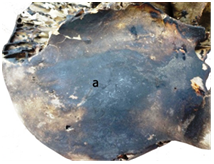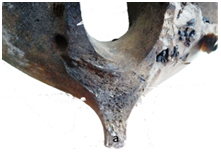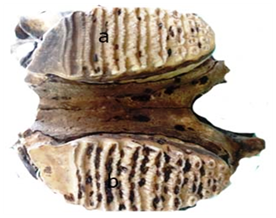MOJ
eISSN: 2471-139X


Case Report Volume 2 Issue 6
1Department of Veterinary Anatomy & Histology, India
2Director, Centre for Wild life Health, India
Correspondence: Srinivas Satapathy, Department of Veterinary Anatomy & Histology, CVSc & AH, OUAT, Bhubaneswar, 751 003, India
Received: May 28, 2016 | Published: August 9, 2016
Citation: Sathapathy S, Dehuri S, Mishra UK, et al. Sex, age and height determination in Asiatic elephant (Elephas Maximus): a case study. MOJ Anat Physiol. 2016;2(6):170–172. DOI: 10.15406/mojap.2016.02.00068
The present investigation was carried out on the skeletal remains of a dead Asian elephant (Elephas maximus) presented to the Centre for Wildlife Health, OUAT, Bhubaneswar by the District Forest Officer, Chandaka suspected of dying due to burning to determine the sex, tentative age and height of the animal. Basing on the morphology of skull, i.e. rounded and convex parieto-occipital crest, absence of temporal line in the postero medial wall of the temporal fossa and thin, short and pointed lip bone, it was confirmed that the suspected elephant was a female one. The tentative age of the animal was found to be about 6years basing on the number of lamellae present on the table surface of molar tooth. The tentative height of the animal was ascertained from the shoulder height or height of the fore limb, which was found to be about 6 feet. This study will help explore new avenues in the forensic wild life science in dealing with the vetero legal cases.
Keywords: sex, age, height, asiatic elephant, fragmentation, caudal vertebrae
The Asian or Asiatic elephant1 is the only living species of the genus Elephas and is distributed in Southeast Asia from India in the west to Borneo in the east.2 They are the largest living land animals in Asia and are primarily threatened by degradation, fragmentation loss of habitat and poaching.1 Female captive elephants live beyond 60 years when kept in semi-natural surroundings, such as forest camps, but die at a much younger age and are declining due to a low birth and high death rate when kept in the zoos.3 In general, the Asian elephant is smaller than the African elephant and has the highest body point on the head. The back is convex or level.4 The ears are small with dorsal borders folded laterally. It has up to 20 pairs of ribs and 34 caudal vertebrae. The feet have more nail-like structures than those of African elephants, i.e. five on each forefoot and four on each hind foot. It becomes very difficult for a wild life expert or an Anatomist to differentiate the sex and to determine the age and height of an elephant when only the skeleton is available due to availability of scanty literature in this regard. So, the present investigation was carried out on the skeleton of the dead Asian elephant (Elephas maximus) to determine its sex, tentative age and height by investigating on the skeleton provided.
The present investigation was carried out on the skeletal remains of a dead Asian elephant (Elephas maximus) presented to the Centre for Wildlife Health, OUAT, Bhubaneswar by the District Forest Officer, Chandaka suspected of dying due to burning to determine the sex, tentative age and height of the animal. Most of the facial bones such as nasal, lacrimal, malar, distal part of the frontal bones were completely burnt. An investigation was carried out to ascertain the sex, tentative age and height of the animal. The sex of the suspected Asian elephant was determined based on the morphology of skull.5 The tentative age of the animal was confirmed basing on the number of lamellae on the table surface of molar tooth6 and the tentative height of the animal was ascertained from the shoulder height or height of the forelimb.7
Determination of sex
The sex of the suspected Asian elephant was determined based on the morphology of skull.5 The following findings played important role in determining the sex of the animal. The Parieto-occipital crest was found to be rounded and somehow convex on the dorso-median region of the skull (Figure 1), in contrast the said crest is reported to be concave or distinctly depressed on the median plane of the dorsal boarder of the skull of a male elephant. On examination of the postero-medial wall of the temporal fossa of the suspected elephant no temporal line was observed, rather, the area was smooth. As per literature, if the temporal line is present on the postero-medial wall of the temporal fossa of the skull of elephant, then it belongs to male sex. Therefore, absence of temporal line in the said location of the suspected elephant skull authenticates its female sex (Figure 2). On examination of the lip bone of the mandible of the suspected elephant, which is located as a median projection from the anterior end of the mandibular symphysis, it was found to be thin, short and pointed (Figure 3). This is the character of lip bone in case of female elephant. However, in case of males, this bone appears to be elongated, dropped downwards and somehow thick and broad. From the above three gross morphological observations on the skull bones of the suspected elephant, it was concluded that probably the suspected dead elephant was a female one.

Figure 1 Cranial view of skull of female Asian elephant (Elephas maximus) showing
a) Rounded Parieto-occipital crest.

Figure 2 Lateral view of skull of female Asian elephant (Elephas maximus) showing
a) Smooth temporal fossa.

Figure 3 Dorsal view of mandible of female Asian elephant (Elephas maximus) showing
a) Thin, short and pointed lip bone.
Determination of age
The age of the Asian elephant depends on the number of closed loop called lamellae or lamina on the table surface of the molar tooth (Figure 4). In the present study, it was found that the enamel fold pattern on the table surface of the upper (6”x2.5”) and lower 3rd molar (6”x2.5”) revealed about 9 close looped (U-shaped) lamellae.7 On comparison with the literature on the dentition pattern of the Asian elephant, It was found that the second molar (eight no. of loops) totally replaced by third molar by 6th year and one extra loop was about to grow.8 So, the approximate age of the animal was speculated to be 6years.

Figure 4 Dorsal view of lower 3rd molar teeth of female Asian elephant (Elephas maximus) showing
a) Table surface, b) Lamellae.
Determination of height
The current literature reveals that the height of the Asian elephants depend on their shoulder height.8 Hence in the present investigation, the measurements pertaining to the bones of fore limb were considered to estimate the height of the shoulder for assessment of animal height (Table 1). The lengths of individual bones of fore limb were summed up for shoulder height, which comes to 70inches (i.e., 70inches/12=5.83feet). Thus the estimated tentative height of the suspected dead elephant was about 6 feet.
Bone |
Length (in Inch) |
Scapula |
18 |
Humerus |
22 |
Radius and Ulna |
18 |
Capals, Metacarpal including Phalanges |
12 |
Total |
70 |
Table 1 Length of bones of forelimb
From the present investigation, it was confirmed that the suspected elephant was a female one and about 6 years old. The tentative height of the animal was found to be 6 feet. It is confirmed that the sex of the Asian elephant can be determined by studying the morphology of skull. Similarly, the tentative age can be calculated by counting the number of lamellae present on the table surface of the molar teeth. Further, the tentative height of the animal can be ascertained by the shoulder height which can be determined by summing up the lengths of the bones of the fore limb.
None.
Author declares that there is no conflict of interest.

©2016 Sathapathy, et al. This is an open access article distributed under the terms of the, which permits unrestricted use, distribution, and build upon your work non-commercially.